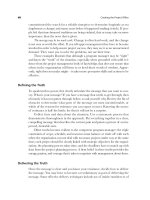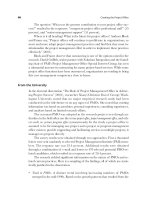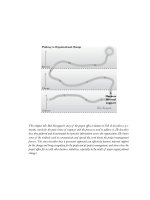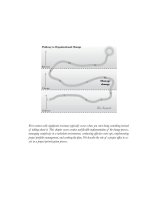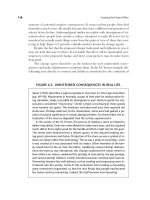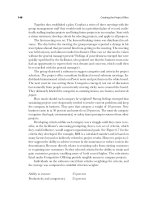Tài liệu Creating the project office 30 docx
Bạn đang xem bản rút gọn của tài liệu. Xem và tải ngay bản đầy đủ của tài liệu tại đây (122.26 KB, 10 trang )
membership is not possible. Training upper management to use authentic com-
munication techniques promotes open, risk-free communication about problems
that may arise. PMO personnel can constantly be training in the latest project man-
agement best practices, data-gathering procedures, and consulting techniques.
For Means, the PMO can supply all tools necessary to implement the project
process from project selection to the end of the project outcome life cycle. Pro-
vide a way for managers and project managers to put a project on hold if it does
not have sufficient resources. Provide planning tools to project managers and func-
tional managers to help them determine the work they require of team members,
and how they might adjust that to meet the needs of each member’s functional
manager. Develop a process to enable communication about projects throughout
the organization; the PMO can serve as the hub. The support group can acquire
diagnostic tools such as PEAT to help them develop methods for closing gaps be-
tween the present state of project management and a more desired future state.
For Motivation, the PMO can point out the dangers of proceeding if projects
do not have adequate resources. Holding both project managers and functional
managers accountable for the utilization and satisfaction of team members helps
to focus them on optimizing human resources. Rewarding the communication of
bad news is one important way to reinforce this behavior. Provide feedback and
coaching to upper managers on open, honest communication actions that sup-
port authenticity and integrity about project work. When possible, the PMO can
run as an internal business, dependent on charging for its services. This structure
supports and motivates an achievement focus, instead of projecting a controlling
atmosphere.
Basic cultural assumptions derive from the status of project management in
the organization. In organizations that recognize project management as a core
business process, issues of performance support are actively under debate and
consideration, even if they may be undecided. In organizations in which project
management is seen as a cluster of competencies for people who happen to man-
age projects, there are more likely to be blind spots about most of these issues.
Communication and Information Systems Support
Communication and information systems support, the seventh success factor, is
supported by an updated project plan that allows all stakeholders to easily obtain
project information. This factor signifies an environment in which it is easy for
team members to communicate with all other project stakeholders. It depends on
a management information system developed specifically to support project man-
agement. The most important source of project information comes from project
reviews, which need to be held regularly, and the findings need to be shared across
the organization.
268 Creating the Project Office
For Leadership, the PMO can specify formats for project documents designed
for easy understanding by everyone, as well as methods of distribution and post-
ing so they are easily accessible to all stakeholders. Specifying a liberal policy for
open access to stakeholders by project team members helps support this success
factor. To help the organization make the best use of project management knowl-
edge, the PMO can aid in the implementation of a project information system,
and facilitate project reviews at each major milestone and a final review at the
end. In addition, it can evangelize and institutionalize knowledge management
processes for project review data and lessons learned. The PMO can sponsor con-
ferences or forums where interested and informed people gather to interact and
share their insights.
For Learning, train project managers and team members how to write clear
documents and how to post them. Train project team members in communica-
tions and how to optimize their contacts with stakeholders—competencies often
lacking in technically trained project managers and team members. Reciprocally,
also train stakeholders how to respond appropriately when approached by project
members. Everyone should be trained to input data into any knowledge man-
agement system, run the system, and use the output of the system. Project man-
agers, team members, and upper management can benefit from training on how
to conduct a project review and why it is important to prevent reviews from being
formalistic and without real substance—or worse, a search for scapegoats. To sup-
port a knowledge management system, the PMO can train project managers and
team members how to input data from their project reviews and how to access
data at the beginning of their projects to learn from other projects’ experience.
For Means, the provision of templates for project documents and communica-
tions supports this success factor, as does supplying an electronic system for posting
documents, making them easily accessible to all stakeholders while maintaining se-
curity and version control. Providing guidelines, e-mail addresses, phone numbers,
and other appropriate access information is important to supplement the electronic
database. In some cases personal contact may be more frequent than database ac-
cess. Inform stakeholders who are on the list and request that they respond when
contacted. The PMO can support the use of the formal system by providing re-
minders, training aids, and help screens. Providing a project review process and tools
to support it, designing the process carefully, and installing an electronic storage and
retrieval system are all important supports for this success factor. Providing an in-
formal community chat bulletin board for project managers and team members will
be a first step in helping to develop a community of practice.
For Motivation, the PMO can follow through to ensure all managers and
stakeholders use the system, reward and recognize those who use it, and highlight
consequences for those who do not. Reinforce proper contact behavior for team
members by sharing observations and supplying personal feedback. Devise metrics
Looking Forward 269
that make stakeholders accountable for responding to team member requests (and
make sure those metrics lead to consequences when people do not respond to re-
quests). Positively reinforcing proper use of the system will probably not be
enough. Making it user friendly to promote use will go a long way toward sup-
porting its use. Get explicit commitments that project managers, sponsors, and
review board members will conduct project reviews and take action on their find-
ings. If a knowledge management system is set up and its use is ignored, it will
probably languish. There is no better way to extinguish desired behavior than to
ignore it.
Basic cultural assumptions that support this factor are espoused acknowledg-
ment that information and knowledge management are important open processes
for the success of the company. An inhibiting assumption would be that knowl-
edge is power and everyone should closely guard their knowledge rather than
share it. Another inhibiting assumption would link a need-to-know norm to knowl-
edge based on position or status. Times of great changes place a huge burden on
communication systems, which can either support or hurt the change initiative,
depending on the values of its leaders and how well good communications are
supported by the project office.
Organization Support
Organization support is the eighth success factor. This depends on how well the
organization supports project management best practices. It includes supporting
teamwork, applying a consistent project management process, and defining the
role of project manager as a professional position with specific selection criteria
and career path. This factor is a measure of important aspects of the organiza-
tion’s culture necessary to support project management over the long term.
For Leadership, the PMO can specify that rewards and recognition will con-
sider teamwork as a crucial factor. Encouraging the use of one adaptable process
across the organization, with variations based on project size, complexity, and type,
helps to achieve common terminology and consistent expectations through project
life cycles. Designating project manager as an official job title with a recognized ca-
reer path is crucial. Project management as a professional position is supported
by establishing a standard selection process, as is emphasizing that project man-
agement is a core business process essential for business success.
For Learning, the PMO can train managers to set goals for performance in
terms of contribution to the project team rather than in terms of individual be-
havior. It can provide training so everyone understands how to use the adopted
project management process. The process can be further supported by training
project managers in a curriculum that meets the needs of the type, size, and com-
270 Creating the Project Office
plexity of projects they will work on. A certification process can qualify them for
progressive levels of size and complexity as they gain training and learning on the
job. All training can include technical process and techniques, leadership, and
business skills. The PMO can provide learning resources to reinforce these factors
over time.
For Means, the PMO can develop a formal process that rewards teamwork
appropriately. Design a process that can be modified depending on the size and
complexity of projects. Develop a tailored curriculum for project managers to
meet specific needs. Specifying or adopting a certification process based on prac-
tice as well as formal education helps ensure that project managers apply their
knowledge to create successful projects rather than just pass certification exams.
Supply performance support tools to support a common and consistent use of the
project management process throughout the organization.
For Motivation, the PMO can hold everyone involved in the project ac-
countable for the outcome, process used, and the work of the team as a whole.
Enlist support from project sponsors and review board members to support proper
use of accepted processes. Push for established career paths specifically for project
managers. Rewarding project managers appropriately with competitive compen-
sation and tying that compensation to certification as well as performance helps
tremendously to support this success factor.
Basic cultural assumptions related to this success factor are associated with the
status and prestige of project management and of project managers in the orga-
nization. If project management is considered a core business process, the organi-
zation is much more likely to support professional education for project managers
as well as a career path for them. If project management is viewed as a set of com-
petencies to use tools and techniques rather than as an organizational process, you
may still see support of project management education and career paths. What re-
mains missing would be everything else that we have laid out here.
Economic Value Support
Economic value support is the ninth success factor. This is based on how well the
environment supports entrepreneurial or business-focused behavior for the project
manager and team. The includes projects’ being based in part on a business case
that includes market analysis, cash flow, investment analysis, and a listing of all
assumptions. When this factor is strong, project managers are fully involved in de-
veloping the business case with the support of Marketing and Finance rather than
just handed a final business case after the project is approved. The team reviews
the business case as part of project start-up. The business case is developed into
a business plan as part of the overall project strategy and planning process. The
Looking Forward 271
core project team includes key members who will have primary responsibility for
managing operations to achieve the project outcome. Information is collected re-
garding the success of the project outcome, then it is compared to the business
case as part of the lessons learned by the organization. This factor is a measure
of how much the organization emphasizes return on investment and shareholder
value as important requirements for project success.
For Leadership, the PMO can specify a standard for developing a business
case as part of the project selection process and require the involvement of Fi-
nance and Marketing with project managers to make sure the cases are sound.
Identify the role of the project manager in developing the business case and the
project team in reviewing the case as part of the project start-up. The PMO can
strongly mandate that members of the core team include a key representative of
those responsible for operating the project outcome to promote a more holistic
development of the total project venture. Developing a review system for an op-
erate-and-evaluate outcome phase of the project and incorporate learning into
the project review system will go a long way to broaden the perspective from
project-centric to venture-oriented for creating shareholder value.
For Learning, the PMO can develop business acumen among project man-
agers and upper managers involved in project selection. Consider simulations and
what-if analysis case exercises to develop the business acumen of all project man-
agers and team members. This training encourages all team members to develop
a commercial mind-set and make decisions with the commercial success of the
project outcome in mind.
For Means, providing templates and tools to carry out business case analy-
sis helps to support it, as does authorizing the time needed to do the job. Further
support comes from providing performance support tools to promote translating
business cases into project goals and specifications, and incorporating them into
project plans. Use these tools to supply inputs to decision support systems dur-
ing project execution.
For Motivation, the PMO can hold the relevant actors responsible for their
roles in developing proper business cases. Engaging the team in a discussion about
the business goals for the project helps incorporate these goals into the team’s be-
havior. Holding the team responsible (along with other organizational associates)
for the business success of the project provides the natural consequences to rein-
force venture-oriented behavior. Holding the project manager and team account-
able for creating a project outcome that meets the commercial goals set out in the
business case helps to promote the development of more realistic business cases.
A basic cultural assumption supporting this factor is that everyone can and
should influence the economic profit of the organization. Another is that project
management is connected to the process of asset utilization that is important for
272 Creating the Project Office
